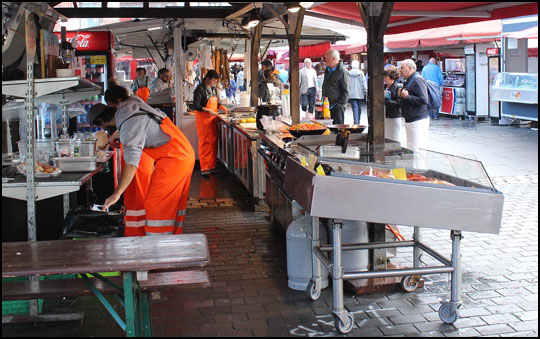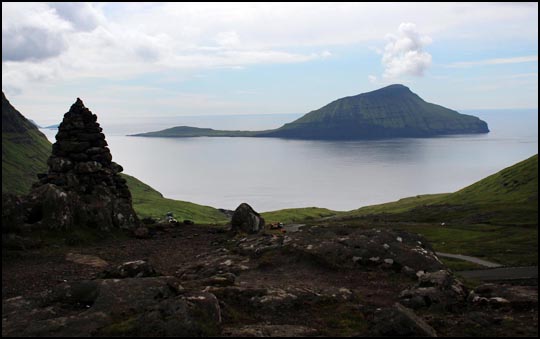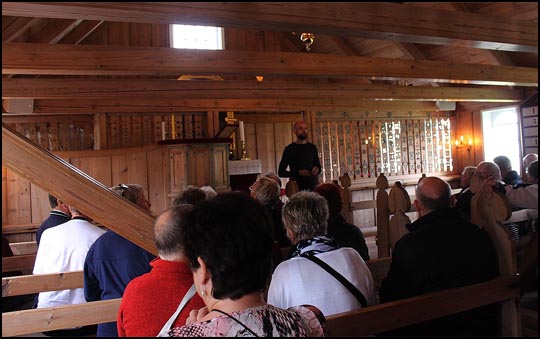Wednesday 9 August 2017. Our second visit to Bergen in Norway and we are looking forwad to seeing it again.

Before breakfast we come out onto the Promenade Deck to watch our approach to Bergen in Norway. We are up early because we are booked on a half-day trip which will include going up on the cable car to the top of the mountain.

First though it takes us on a little tour of the city, starting at the fish market. This is just a short photo stop, though our guide, Andrea from Venezuela, walks with us to the market to point out, amongst other things, whale meat.

There is quite a number of ships in the harbour and we'll have a closer look at some of them later on.

One of the fish stalls on the market. You will also find stalls with fruit and veg on this market and even some stalls selling food both for take-aways and a few with a collection of benches and table under a canvas roof.

A closer look reveals some huge crab legs and claws - krabbe-klor on the extreme left!

They were giving free samples slices of whale meat. Not for me. I'm no vegetarian but I draw the line at eating such intelligent creatures... That is what he is slicing up on the right. On the whale watching trip in Akureyri they told us that hardly anyone other than tourists eat whale meat now and begged us not to try it.

The Bryggen is the old town of Bergen. We have visited it before but now we get a chance to see it from across the harbour. We can see the track of the cable car leading up the hillside in the distance. I'm looking forward to that!

However, back to Bergen! We were now on the other side of the harbour to where we had visited before and there are old wooden buildings on this side also! The hill on the right looks as though it could be the one that I drew from a photo on our sea days approaching Iceland!

This part of the excursion was mostly a drive around this part of the town. The part that we were waiting for came after our round-town drive - the trip up the cable car.

But if we thought we would miss having to queue for ages we were disappointed as we were in a line for around 40 minutes or so before we got into the station and realised that there was a massive queue in there as well! Eventually we got to the front of the queue and made it onto the train.

We were not in a good position to take photos of the ride up - but we will be on the way down! At the top we found Andrea and told her we would make our own way down and leave the tour at this point. This would allow us to have a wander around the Bryggen and its shops at leisure. The view of Bergen, its fjord and the sea beyond is really excellent.

We make the most of the viewing area, taking in the inland side of Bergen as well as the port. The bridge to the left carries the European Route E39 across the end of Bergen's fjord. This route stretches 830 miles (1330 km) from just south of Trondheim in Norway down to Aalborg in Denmark. The road from end to end involves taking to a ferry an incredible nine times - the most ferry sections of any single road in Europe.

The peninsular in this view is where we took our drive earlier. The fish market can be made out as the bright red stalls, bottom left, and a Costa ship - Costa Magica - is in the port on the right, near to Thomson Celebration.

We have a little wander about the hilltop, finding some goats in a hut and evidence of their freedom in plenty along the path... We also had a look in the shop and I found it wasn't only Fran and the other ladies who had to queue to visit the toilets but the queue for the Gents was only a little one. We join the short queue for the cable car down.

This time I made sure to get a spot which gave us a good view of our descent! Several times the roadway crosses the train track - the road involves a few more hairpin bends than the train requires!

The halfway point. Apart from this short section where the climbing and descending cars pass, the cable car is single track. A hairpin bend can be seen on the road to the left and the roadway again crosses the track in front of us.

We reach the short tunnel that leads into the station at the bottom of the hillside. The car slows right down as it approaches the waiting queues of people waiting for the journey upwards. We get out to the left whilst they enter on the right. Automatic barriers ensure that the correct number of passengers get through to wait next to the track for boarding so that there is minimal jostling and risk of someone falling.

Spot the vertical! The old shops of the Bryggen. Miss Franny is standing under the word Knut.

Two of the shops are having work done to their frontages, but have been hung with painted material so that they keep an approximation of their normal appearance.

Walking through archways (there's one near the middle of the previous photo) takes the visitor through to the very narrow streets of the medieval Bryggen. Most of the original houses have been burned down and rebuilt several times since medieval days, but always to the same design and appearance. As a result if you were suddenly transported back to the 1400s you would find yourself in the midst of the same buildings and street plan.

We say Goodbye to the Bryggen and head back towards the port and our ship. The Øystrand is a brand new ship, built this year (2017) for carrying live fish. Her bows are strangely bulbous. I suppose the captured fish tried to escape by charging en-masse at the hull in an attempt to break it?

A road train is doing trips, a toy troll strapped to the front of the funnel. "Mind that car!!!" it kept shouting...

CMV Cruises ship Columbus looked strangely familiar but it was not until we got home and looked it up that I realised we had actually sailed on her under a different guise. She was built in France in 1988 for the Italian cruise line Sitmar and was launched as Sitmar FairMajesty, but in the same year the Sitmar line was sold to P&O and the ship was sold to Princess Cruises sailing from 1989 to 1997 as the Star Princess.

In 1997 she joined the P&O fleet and was renamed Arcadia. From 2003 to 2010 she served as Ocean Village which was how we came to sail on her in 2010. I took the above photo on 25 April 2010 in Limassol, Cyprus. The Ocean Village brand was a P&O line catering for those who preferred a less formal cruise. When the brand ceased in 2010 she joined P&O Cruises Australia as the Pacific Pearl and was sold to Cruise and Maritime Voyages to serve as CMV Columbus just this year.

The Rosenkrantz Tower is part of Bergen's Bergenhus Fortress. It is a 16th century enlargement of the original castle keep of 1270. Behind the white building can be seen the stepped gables of Haakon's Hall, built at the start of the second half of the 13th century. It was badly damaged in World War II by the explosion of a Dutch ammunition ship, this event being described a few days ago when we were in Stavanger at the beginning of this cruise (see entry posted 15 August 2017).

Costa Magica, built in 2003 was sister ship to the less-fortunately named "Costa Fortuna" and has spent her entire life in service with the Costa Crociere cruise line. We bought some postcards and things from a tiny souvenir shop on the port. The shop owner told us it had rained so hard the previous day that hardly anyone got off from the four ships that were in port that day. We have been incredibly lucky on this cruise!

Back on the ship we take up seats in the Coffee Lounge on Deck 5 and I sketch the coastline of a part of Bergen to the north of the Bryggen Harbour. It includes rocks, water, buildings, bare earth, trees and pine trees - a challenge to make sense of in pencil!









































